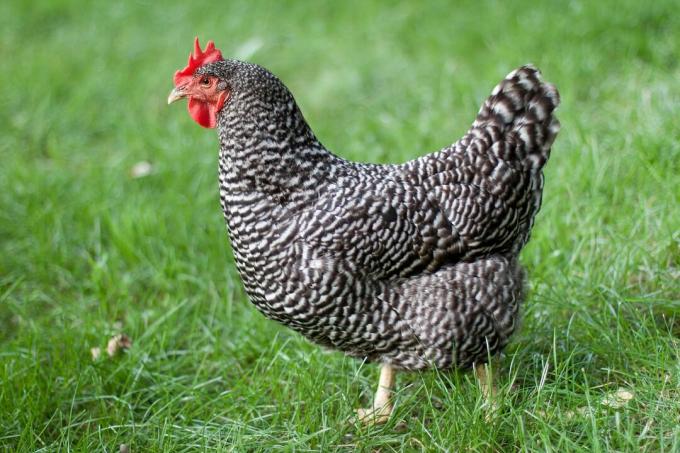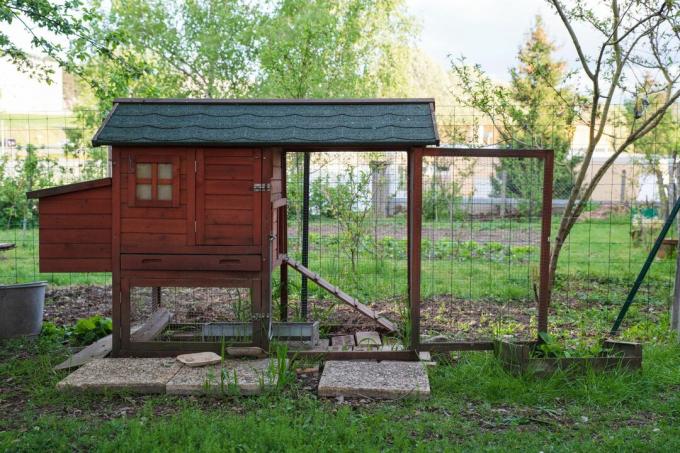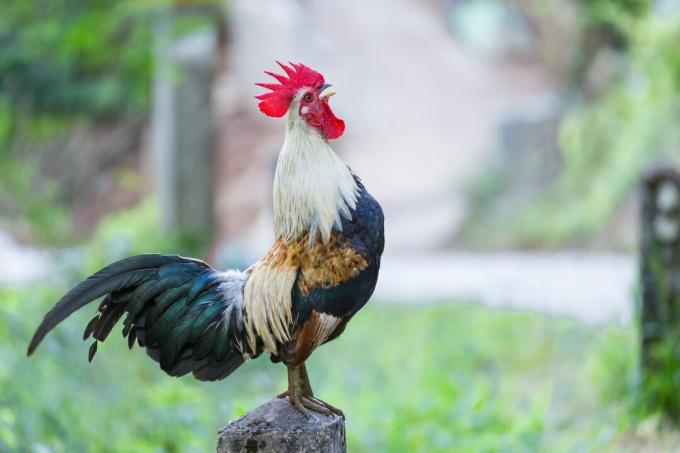Many now choose to get their eggs from their own chickens. We give tips on how to keep chickens in the garden.

When buying eggs, many are unsure: factory farming in particular is repeatedly criticized and tempts animal lovers to do without eggs. In fact, there is a simple solution: If you can get your breakfast eggs from your own garden in the morning, you don't have to worry about questionable animal husbandry. And keeping chickens in your own garden can do even more: Not only are the chickens a real eye-catcher and extremely interesting to observe, they sharpen the understanding of both children and adults Food. Here we will show you how to keep chickens quickly and easily.
Chickens are not only pretty to look at, but also really useful. We have put together the ten best tips so that your garden can soon become a paradise for chickens.
contents
- 1. The right breed of chicken
- 2. Buy chicken coop
- 3. Build your own chicken coop
- 4. Chicken coop: The right equipment
- 5. The laying box
- 6. Design of the chicken run
- 7. feeding chickens
- 8. Keeping chickens: Registration at the veterinary office
- 9. Keeping chickens: Building law and neighborhood disputes
- 10. chicken farming in the city
1. The right breed of chicken
Did you know that there are a number of different breeds of chickens? In fact, the European Breeding Poultry Standard lists over 180 chicken breeds. There are also different colors within the breeds and foreign exotics. All these breeds differ not only in their appearance, but also in their temperament and their There are big differences in other characteristics - this can be confusing for newcomers to chicken farming be. Luckily, there are some chicken breeds that are highly recommended for beginners. Especially old breeds like Plymouth Rocks or Orpington are considered to be extremely robust, but at the same time they are quite trusting. Barnevelders have the advantage of not being able to fly - ideal for free range in the garden. Those who attach great importance to good laying performance should take a closer look at the Sundheimer. Not only do they lay up to 200 eggs a year, they are also extremely easy to care for.

2. Buy chicken coop
In addition to choosing the right breeds, the stable is particularly important for successful chicken husbandry. There are now some chicken houses and aviaries that are delivered ready for assembly. These ready-made solutions are a great alternative, especially for people without much manual experience or with limited time. However, you should make sure that the chicken house is not covered with roofing felt (here the red mite can quickly nest). Even if the price is too cheap, you should be suspicious - the quality is often not right here and the chicken coop does not survive wind and weather unscathed.
Recently, there are also chicken coops that are made entirely of plastic. Although these do not shine with a rustic ambience, they are often assembled much faster and can be cleaned much easier later. Finally, the question arises whether you would rather own a mobile or a fixed chicken coop. Mobile stalls have the advantage that moving them protects the floor in the run. They are therefore particularly interesting for larger gardens. Fixed chicken coops, on the other hand, are particularly safe from predators and can be more individually adapted to the needs of the chickens.
3. Build your own chicken coop
Building your own chicken coop has a number of advantages: You can save significantly on costs and also respond to individual requirements and wishes - such as special shapes or colors. So it's no wonder that many hobby owners swear by homemade chicken coops. However, there are a few things to consider when building a chicken coop. The most important thing is the right size - bantams should have 0.3 square meters of space per chicken, larger breeds even 0.4 square meters. Wood or stone are best suited as materials for self-construction. However, wood is usually preferred because it is not only cheaper to obtain, but also easier to install. On the other hand, concrete or brick have the advantage that they offer better protection against rodents, but also against predators.
If you want a mobile chicken coop, you can also use old trailers as the starting material for this. In addition, sufficient insulation for the chicken coop is essential, because temperatures below 5 °C can affect the quality of the eggs. Draft is also not wanted in the chicken coop. In addition, care should be taken to ensure that there is sufficient incidence of light - Plexiglas is particularly suitable for hobby craftsmen for window construction.

4. Chicken coop: The right equipment
Chickens don’t just need four walls – the inner workings of the new chicken coop are particularly important for their well-being. A sufficiently thick layer of litter – for example straw, wood shavings or hay – should be used as the floor covering. This not only binds the legacies of its new residents, but is also an excellent activity material that invites you to scratch and peck. So-called automatic feeders are best suited for feeding and sufficient water supply overnight: This is where the food is or the water is filled into a large container and then flows independently into a channel from which the chickens help themselves be able.
Incidentally, the chickens do not need their nest to sleep, but a so-called perch. In order for the chickens to be comfortable here, the pole should be as round as possible and about five centimeters high. In addition, the perch should be placed in the upper third of the coop, as chickens seek shelter in higher places during the night. In order to prevent disputes and lack of space, it is worth having several perches (also on several levels) - at a minimum, each chicken should be at least 25 to 30 centimeters of space to have.
5. The laying box
In addition to their coop, the hens need a separate nest that they can use for laying eggs. A simple wooden box measuring 35 x 40 x 40 centimeters, which has been sprinkled with sufficient hay or straw, is often sufficient. However, laying boxes can also be bought ready-made from specialist shops, where they are often equipped with ingenious techniques for collecting the eggs. Incidentally, the laying boxes are particularly well received when they are slightly elevated - a flap for removing them from the outside makes daily egg collection easier. Especially at the beginning it can happen that the chickens do not accept the nest and put it in the stall or in the run, for example. A simple trick can help here: A dummy egg (e.g. a plaster egg, but also plastic or marble eggs from the Easter decorations) in the nest ensures better acceptance. One laying box should be used for five chickens, but two nests should still be available if there are fewer than five chickens.

6. Design of the chicken run
Of course, chickens shouldn't sit in their barn all day, but should also explore their environment. In fact, you quickly find out that chickens are very curious - and that they are great to watch, especially in the run. The coop should be equipped with a chicken hatch so that the chickens can freely choose between the run and the coop throughout the day: Approximately 25 centimeters wide and 40 centimeters high, this gives the hens a free choice of space without the large door remaining open got to. So that the animals do not gather the bedding from the stable, it is worth opening the flap almost 30 centimetres above the ground - a chicken ladder can be the entrance for the hard-working hens later facilitate. However, this flap must also be closed overnight, otherwise Fuchs and Co have an easy job.
The run should always be three square meters per animal, if the turf is to be protected, even 20 square meters per animal is advisable. The outlet is limited by a fence, which (depending on the breed) should have a height of about one meter to 2.5 meters. Wire mesh has proven particularly useful here, but special mesh fences for chickens can also be used. When designing the outlet, the following applies: the more natural, the better. English lawns are relatively unpopular with chickens because they don't offer them any hiding places. Bushes, hedges and trees in the run are ideal and offer additional protection from the weather. Mobile stables with alternating pastures are also popular with chickens: Not only can the turf recover, but the animals can also pursue their natural curiosity.
7. feeding chickens
Everyone knows that chickens need food - but what exactly they should be fed with raises questions for many beginners. The basic ration when keeping chickens should consist of grain feed (e.g. wheat or crushed corn). In addition, you should offer special laying meal, as this provides the hens with enough minerals and vitamins for egg laying. In addition, of course, sufficient fresh water is part of the daily feed ration. But chickens also like variety. In fact, the animals are real omnivores, making a compost heap almost superfluous make: vegetables and fruit, but also hard bread and pasta or even quark are among the favorite foods of the hard-working Animals. But animal protein also needs to be taken care of. Chickens not only love to eat insects, but also pick and choose leftover meat from bones. Only strongly seasoned, moldy or spoiled food does not belong in the feed bowl - these can also lead to serious illnesses in chickens.

8. Keeping chickens: Registration at the veterinary office
Bureaucracy in chicken farming? Yes, they really do exist - chickens must be registered with the Animal Disease Fund and the relevant veterinary office, even if they are kept as a private hobby. Depending on the federal state, however, this is not necessarily associated with costs: in Schleswig-Holstein, for example, keeping up to 25 animals is free of charge. In return for registering with the Animal Disease Fund, chicken owners can receive compensation, if animals die due to an animal disease or are killed due to an official order have to. If, on the other hand, the animals are not registered, it can be expensive: Not only compensation payments can be made in this way be deleted, the veterinary office can also impose fines on chicken farmers who have not registered their animals, impose.
9. Keeping chickens: Building law and neighborhood disputes
Chicken farmers not only have to be careful when registering for animal diseases: Laws have to be observed in many other areas as well. For example, the building use ordinance must be taken into account - according to this, every four hens are allowed and keep a rooster in his garden, since they are small animals like rabbits or guinea pigs acts. While there are hardly any problems with mobile chicken coops of this size, you should take a look at the local building law for larger numbers of chickens or permanent coops. Here you will find the respective regulations, including maximum sizes or the minimum distance to the neighboring property. Speaking of neighbors: In order to avoid quarrels, it is advisable to inform the surrounding houses in advance about the purchase of chickens. The rooster crow in particular can otherwise lead to one or the other difference of opinion. If you want to avoid this in advance, you can use time-controlled flaps and good insulation of the stable for a pleasant rest worrying about early mornings and late evenings - even not having a rooster can keep the peace on the street to back up.

10. chicken farming in the city
Keeping chickens on the terrace or even the balcony? At first glance, this idea confuses most people. In fact, keeping chickens on the terrace is no reason to call animal welfare - quite the opposite. Even in the city, chickens can lead a species-appropriate life under the right conditions. The basic condition for keeping chickens is, of course, first of all enough space - so a green roof is much better suited than a small balcony. Otherwise, the same rules apply as for keeping chickens in the garden: A stable as Weather protection with complete interior furnishings should be available and the run must be sufficient be secured. In addition, the run should be equipped with potted plants and small hiding places to create retreat opportunities for the chickens. By the way, bantam breeds are particularly suitable for keeping in smaller spaces, as they generally require less exercise and have a calmer disposition. However, you have to realize that keeping them on the terrace or balcony involves a considerable amount of extra work - and keeping it close to the house also means an unpleasant smell and complaints from the neighbors can bring.
Do you not only want to keep chickens, but also bees yourself? Then you will find our contribution here "Ways to becoming a hobby beekeeper: Instructions & tips from professionals".
...and receive concentrated plant knowledge and inspiration directly in your e-mail inbox every Sunday!


